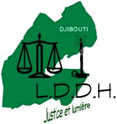13/10/08 (B469) LDDH : deux rapports de HUMAN RIGHTS WATCH qui dénoncent les disparitions forcées en Ethiopie avec évidemment la complicité de l’Administration de Washington.
 Le Président |
DIFFUSION D’INFORMATION DU 11 OCTOBRE 2008. Ci-après deux rapports de HUMAN RIGHTS WATCH |
Le second rapport a déjà été diffusé sur leur site par l’Association pour le Respect des Droits de l’Homme à Djibouti (ARDHD). (Lien)
En ce jour, l’ouverture d’un Atelier « de Travail » et non de Formation sur les droits de l’Homme organisé par le Ministre de la Justice et des Affaires Pénitentiaires a été accompagné d’un discours, « inhabituel », car très engageant dans des affirmations dignes d’un Porte parole du Gouvernement, qui a été prononcé par M. SUNIL Représentant du PNUD à Djibouti, toutefois, il est, à notre avis, bon de rappeler aux membres de cet Atelier sur les Droits de l’Homme dans notre pays, même si la LDDH a été soigneusement écartée, l’une des dures réalités existantes dans l’ensemble de notre sous région.
PJ. POUR OBSERVATIONS
La Ligue Djiboutienne des Droits Humains (LDDH), dans le cadre d’une bonne compréhension de ses Devoirs de Défenseur des Droits de l’Homme et des risques inhérents suite au manque de protection des journalistes en Somalie, en Ethiopie, en Erythrée, et l’inexistence de Presses Libres en République de Djibouti parrainée par les Forces armées stationnées sur son Territoire, ne peut que soumettre en Annexe et pour rappel certaines de ses communications de 2008.
Espérons que, pour ce 60ème anniversaire des Défenseurs des Droits de l’Homme, les Nations Libres ne soient plus induites en erreur, et que le silence mortel prendra fin.
Ce silence sur les crimes de guerre, les crimes contre l’humanité, les crimes de génocide notamment en Somalie du Sud et en Ogaden, sur les violations dramatiques dans notre sous région de la Corne d’Afrique, ce silence est, et, reste mortel, ce silence sera, et, restera inscrit dans les Mémoires de toutes les Victimes et les Populations concernées.
M. NOEL ABDI Jean-Paul
_________________________________________
a. THE DISAPPEARED
In April 2007, the Ethiopian Ministry of Foreign Affairs acknowledged that Ethiopia was holding in its custody at least 41 individuals who had been transferred from Kenya. It subsequently released all the women and children, as well as several men, between April and August 2007.
But Ethiopian officials have never acknowledged the detention of the other rendition victims, even though all accounts indicate that the more than 85 men and women flown to Somalia from Nairobi were handed over to Ethiopian military forces then operating in Somalia as soon as they landed. Human Rights Watch’s request for information from the Ethiopian authorities (see Appendix A) was never answered.
As discussed in the section International Legal Standards below, an enforced disappearance occurs when state officials or agents arrest or detain an individual followed by a refusal to disclose the fate or whereabouts of the person or a refusal to acknowledge the deprivation of their liberty, which places the person outside the protection of the law.35
Nine Kenyan nationals and one Canadian-Ethiopian remain in Ethiopian prisons, some 15 to 21 months after they were first arrested. The whereabouts of 22 Somalis, Ethiopian Ogadenis, Eritreans, and Kenyans rendered to Somalia in early 2007 remain unknown.
The following men are known to be in custody in Addis Ababa:
Bashir Makhtal, a dual Canadian-Ethiopian citizen, born in Ethiopia and granted refugee status by Canada in 1991. Kenyan officials arrested Makhtal at a border crossing in December 2006, secretly flew him to Mogadishu on January 20, 2007, and handed him over to Ethiopian authorities.
Three days later, Ethiopian officials flew Makhtal from Mogadishu to Addis Ababa, where he was placed in solitary confinement and kept separate from other detainees.36 Makhtal’s grandfather was reportedly a founding member of the ONLF, which undoubtedly made Makhtal a prime suspect for the Ethiopians.37
A now-released detainee who last saw Makhtal in July 2007, as Makhtal was being escorted from the toilet at a prison in Addis Ababa, described his condition:
He was limping. He had a deep cut in one of his legs. He looked weak. He looked so famished.38
Still in Addis Ababa, Makhtal is reportedly slated for trial before a military tribunal for terrorism-related activities and could face the death penalty. In July 2008, Makhtal received his very first consular visit in Ethiopia, some 16 months after he had been rendered there. In August 2008, a representative of the Canadian government who met with Ethiopian Prime Minister Meles Zenawi said that Makhtal would have legal representation at his trial.39 But his lawyer continues to be denied access and, as far as Human Rights Watch knows, no subsequent consular visits have been allowed.
Eight Kenyans rendered to Ethiopia in January and February 2007: Said Khamis Mohammed, Kassim Mwarusi, Ali Musa Mwarusi, Swaleh Ali Tunza, Hassan Shaaban Mwazume, Bashir Chirag Hussein, Abdallah Khalfan Tondwe, and Salim Awadh Salim.40
Seven of these men (all but Salim Awadh Salim) were told that they were going to be released in May 2007, only to be moved to a private house that served as a detention facility in the outskirts of Addis Ababa. They were held there for almost a year, before being moved back to an old police station where they had been held previously. There, they rejoined Salim.
In February 2007, another Kenyan escaped from detention. The Ethiopian police reportedly retaliated against the remaining Kenyans, subjecting them to a brutal beating. Officers were said to have broken the leg of Swaleh Ali Tunza, a 40-year-old Kenyan who now fears he may ultimately lose his leg. Another detainee, 50-year-old Bashir Chirag Hussein, is reportedly weak and in constant pain, due in part to the beatings by the Ethiopian police. A third, Abdallah Khalfan Tondwe, said that he can no longer use his left hand. Beatings reportedly compounded the injuries Tondwe suffered in a car accident when being transported from Mombasa to Nairobi after his initial arrest.41
The detainees described insufficient food, inadequate healthcare, and unsanitary conditions in detention. None of the detainees have ever been permitted visits by family members or an international humanitarian organization such as the ICRC, and none have had access to a lawyer since they were brought to Ethiopia.
In phone interviews with Human Rights Watch, the Kenyan detainees spoke of their plight. I can’t sleep well. I miss my family. Please, I need you to help us to go home, said one detainee.42
I am Kenyan. My mother is Kenyan. My father is Kenyan. Everyone else has been sent home. Why am I still here? Why isn’t Kenya helping us? said another.43
In August 2008, Kenyan police officers visited these men for the first time since they were deported. The officers reportedly told the eight Kenyans that they would be released within weeks.44
Adbikadir Mohamed Adana Kenyan-Somali arrested in July 2007 in Kenya. Kenyan officials reportedly drove Adan and two others across the border, where they were eventually turned over to Ethiopian custody. The other two men were released in June 2008, but Adan remains incarcerated in an old police station in Addis Ababa.
He is reportedly being held in solitary confinement in a two-by-two-meter cell, separated from the other Kenyans in the facility.45
The whereabouts of another 22 men who were rendered from Kenya to Somalia in January 2007 remain unknown. These men were listed as passengers on the January 20 and 27 flight manifests, yet have not been heard from since. They may have been released; they may still be in Ethiopian custody; or they may have been transferred elsewhere: 46
1. Tafara Basisarendered 1/20/07 to Mogadishu (reportedly Ethiopian Oromo)
2. Lama Takalrendered 1/20/07 to Mogadishu (reportedly Ethiopian Oromo)
3. Badada Lamirendered 1/20/07 to Mogadishu (reportedly Ethiopian Oromo)
4. Tesfale Kidanerendered 1/20/07 to Mogadishu (reportedly Eritrean)
5. Saleh Idrisrendered 1/20/07 to Mogadishu (reportedly Eritrean)
6. Hussein Ali Saidrendered 1/20/07 to Mogadishu (reportedly Kenyan)
7. Salama Ngamarendered 1/20/07 to Mogadishu (reportedly Kenyan)
8. Saidi Shifarendered 1/20/07 to Mogadishu (reportedly Kenyan)
9. Tsumo Solomon Adan Ayilarendered 1/20/07 to Mogadishu (reportedly Kenyan)
10. Mugeta Tasiifarendered 1/20/07 to Mogadishu (nationality unknown)
11. Nur Mohammad Zainrendered 1/20/07 to Mogadishu (nationality unknown)
12. Mohammad Hassanrendered 1/20/07 to Mogadishu (nationality unknown)
13. Abdullahi Mohammadrendered 1/20/07 to Mogadishu (nationality unknown)
14. Sakata Sakarerendered 1/20/07 to Mogadishu (nationality unknown)
15. Shariff Jamalrendered 1/20/07 to Mogadishu (nationality unknown)
16. Jamal Abdalrendered 1/20/07 to Mogadishu (nationality unknown)
17. Ahmed Hassanrendered 1/20/07 to Mogadishu (nationality unknown)
18. Mohammad Abdullahrendered 1/20/07 to Mogadishu (nationality unknown)
19. Abdijani Ahmedrendered 1/20/07 to Mogadishu (nationality unknown)
20. Abdulrashid Mohamedrendered 1/27/07 to Mogadishu (reportedly Kenyan)
21. Abdi Kadir Maalinrendered 1/27/07 to Mogadishu (reportedly Somali)
22. Hassan Shabanrendered 1/27/07 to Mogadishu (nationality unknown)
